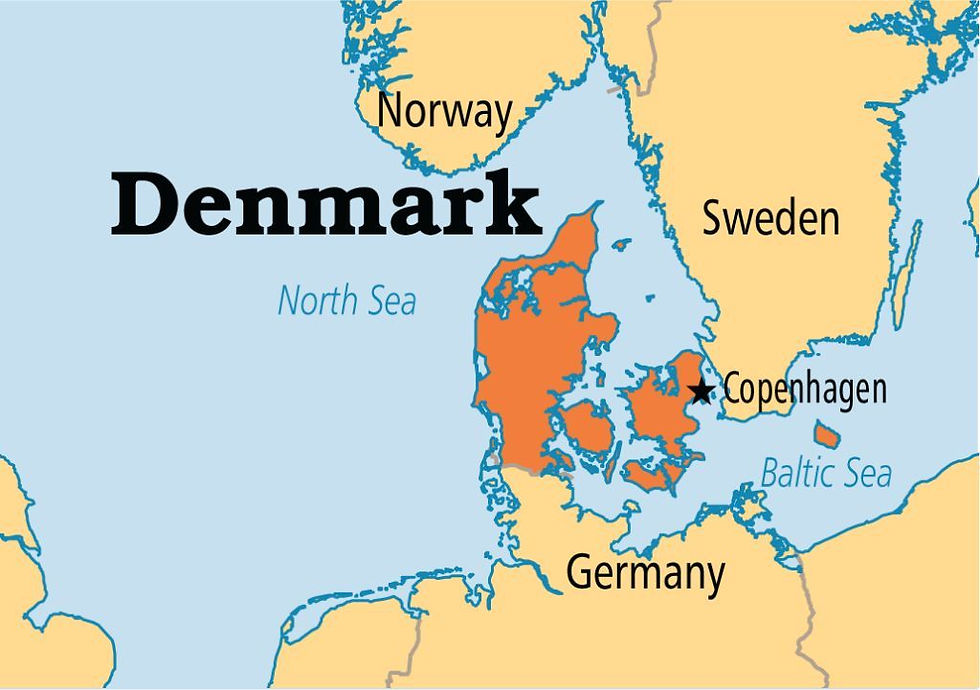Denmark
- To-Go

- Aug 15, 2022
- 4 min read
Updated: Oct 2, 2022
Country Name
Denmark or officially the Kingdom of Denmark.
Location
Denmark is located in northern Europe. Denmark is bordered by the North Sea and the Baltic Sea. Denmark lies southwest of Sweden and south of Norway and is bordered to the south by Germany. Denmark has two independent territories in the North Atlantic Ocean: the Faroe Islands and Greenland.

Capital
Copenhagen.
Reason for Naming
The etymology of the name "Denmark", the relationship between "Danes" and "Denmark", and the emergence of Denmark as a unified kingdom are topics of continuous scholarly debate. This is centered primarily on the prefix "Dan" and whether it refers to the Dani or a historical person Dan and the exact meaning of the -"mark" ending. Most etymological dictionaries and handbooks derive "Dan" from a word meaning "flat land", related to German Tenne "threshing floor", English den "cave". The word "mark" is believed to mean woodland or borderland, with probable references to the border forests in south Schleswig.
Flag
Legend relates that the Dannebrog ("Danish cloth" in Danish) fell from the skies on 15 June 1219, the day on which King Waldemar II defeated the Estonians in battle. The flag consists of just two colors red and white colors.
A white Scandinavian cross is featured on a red background, This cross extends to all edges of the flag.
These colors were selected because the kings of Denmark used a white-on-red cross dating back to the 14th century. The meaning of the Scandinavian cross is simple. This design symbolized Christianity.
Flags featuring the Scandinavian cross are used in all Nordic countries with
the exception of Greenland.
So the white cross represents Christianity, while the red color represents strength, bravery, and hardiness.
*Flag Facts
- The use of the Danish flag was banned for private use from 1834 until 1854. - The national flag of Denmark is the oldest continuously used national flag in the world. - Some regions in Denmark have unofficial flags. These are not recognized by the government and are designated as “fantasy flags.”

Language
Danish is the official & national language in Denmark and is spoken by a majority of the people. A large majority of Danes speak English as a second language, generally with a high level of proficiency.
German is the second-most spoken foreign language, with 47% reporting a conversational level of proficiency.
Faroese and Greenlandic are the official languages of the Faroe Islands and Greenland individually.
Religion
Christianity is the dominant religion in Denmark, most of the residents who do subscribe to a religious faith belong to the Evangelical Lutheran Christian Church of Denmark which is a protestant denomination. Islam the second largest religion in Denmark is Islam, most identified as Sunnis. Other minority Atheists, Agnostics, Roman Catholic Christians, Jews, and Others.
Currency
Danish krone (DKK).

Time Zone
+02:00 GMT. (Summer Time),
+01:00 GMT.
Government Regime
Unitary parliamentary constitutional monarchy.
Climate
The climate of Denmark is cold in winter and mild in summer; being influenced by the ocean. In fact, clouds, humidity, rain, and wind are predominant. The country is small and flat, so there are few climatic differences between the areas, however, the western coasts of the Jutland peninsula are milder, windier, and rainier than the rest of the country. Snowfalls occur from November to the first half of April. In one year, there are 20 to 25 days of snowfall. The winter is cold, with an average temperature of January and February just above freezing at 0 °C. In December, the days are very short, the sun sets at 3:00 in the afternoon, and the temperature changes between day and night are few. when the country is reached by eastern currents brought by the Siberian High, the temperature suddenly drops and may fall several degrees below freezing, down to about -20 °C (-4 °F) in the worst moments. These cold periods may last a few days, usually less so than in Sweden or Finland. Spring is initially cold, and remains cool still in May: the maximum temperature in Copenhagen is on average about 11 °C (52 °F) in April and 16 °C (61 °F) in May. However, spring is the relatively driest season of the year. In summer, the temperatures are usually pleasant: highs in July and August are about 22 °C (72 °F) in Copenhagen and in other major cities (Aarhus, Aalborg, Odense, etc.), while they are a bit lower, around 20 °C (68 °F), on the western coasts bordering the North Sea. Night temperatures are pretty cool, around 13/15 °C (55/59 °F), the southern currents can bring some hot days, which usually last for 2 or 3 days the temperature rarely reaches 30 °C (86 °F), and the highest recorded temperatures are about 33/34 °C (91/95 °F). In autumn, the weather is dull and rainy, and at times windy. In November, the amount of sunshine is minimal as in winter. In Copenhagen, the maximum temperature in September is already about 18°C (64 °F), then it drops to 13 °C (55 °F) in October and to 8 °C (46 °F) in November.
The best time to visit Denmark is in the summer, from June to August. Temperatures are mild or warm during the day, while they are cool or even slightly cold at night; the rains are quite frequent, but they are not heavy and generally do not last long.








Comments